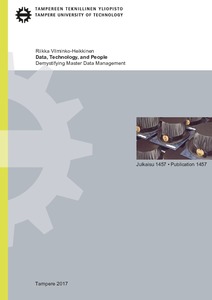Data, Technology, and People: Demystifying Master Data Management
Vilminko-Heikkinen, Riikka (2017)
Vilminko-Heikkinen, Riikka
Tampere University of Technology
2017
Tieto- ja sähkötekniikan tiedekunta - Faculty of Computing and Electrical Engineering
This publication is copyrighted. You may download, display and print it for Your own personal use. Commercial use is prohibited.
Julkaisun pysyvä osoite on
https://urn.fi/URN:ISBN:978-952-15-3914-5
https://urn.fi/URN:ISBN:978-952-15-3914-5
Tiivistelmä
With the amount of data constantly increasing, better practices are needed to manage it. Master data management (MDM) is an organizationally horizontal flow of activities aimed at managing core business data (i.e., master data). MDM differs from traditional data management practices as an organization-wide function. The idea of managing an organization’s most important data is impossible to achieve if MDM is simply treated as a data management practice or a technology-driven phenomenon. Establishing an MDM function involves introducing changes to an organization, which can relate to people and their ways of working, or technology and how it is used. If only a certain aspect is emphasized, the function will not deliver desired results.
The object of this thesis is to study MDM not as a straightforward IT project, but as a complicated and multi-dimensional function. The goal is to understand the factors that should be taken into account in the development of an MDM function. The empirical part of this study is an ethnographic case study in a public sector organization, where MDM development was in early phases when the observation began. Altogether, the two data collection periods lasted for 32 months and during this, two MDM development projects were carried out, and MDM development became rooted as part of the organization’s routine operations.
MDM development was analyzed as an ensemble that includes social and material components. Its theorization begins with understanding the role of master data in an organization’s information landscape and continues to examine the different views of MDM. Theories of change assist in understanding how change should be observed, understood, and managed.
The study indicates that MDM effects multiple levels of an organization. Many organizational factors influence its development, and extensive dependencies exist between these factors. Especially in terms of ownership, other roles and responsibilities assume key positions. By understanding these factors and their roles in MDM development, it is easier to manage them.
The study sheds light on the strong alignment between the complex concept of MDM and the organization. MDM literature is scarce and literature of public sector MDM is almost nonexistent. This dissertation contributes to research by widening the understanding of MDM in the public sector context, and by presenting a framework for establishing an MDM function as an organizational function that is closely linked with technology.
The object of this thesis is to study MDM not as a straightforward IT project, but as a complicated and multi-dimensional function. The goal is to understand the factors that should be taken into account in the development of an MDM function. The empirical part of this study is an ethnographic case study in a public sector organization, where MDM development was in early phases when the observation began. Altogether, the two data collection periods lasted for 32 months and during this, two MDM development projects were carried out, and MDM development became rooted as part of the organization’s routine operations.
MDM development was analyzed as an ensemble that includes social and material components. Its theorization begins with understanding the role of master data in an organization’s information landscape and continues to examine the different views of MDM. Theories of change assist in understanding how change should be observed, understood, and managed.
The study indicates that MDM effects multiple levels of an organization. Many organizational factors influence its development, and extensive dependencies exist between these factors. Especially in terms of ownership, other roles and responsibilities assume key positions. By understanding these factors and their roles in MDM development, it is easier to manage them.
The study sheds light on the strong alignment between the complex concept of MDM and the organization. MDM literature is scarce and literature of public sector MDM is almost nonexistent. This dissertation contributes to research by widening the understanding of MDM in the public sector context, and by presenting a framework for establishing an MDM function as an organizational function that is closely linked with technology.
Kokoelmat
- Väitöskirjat [4769]
